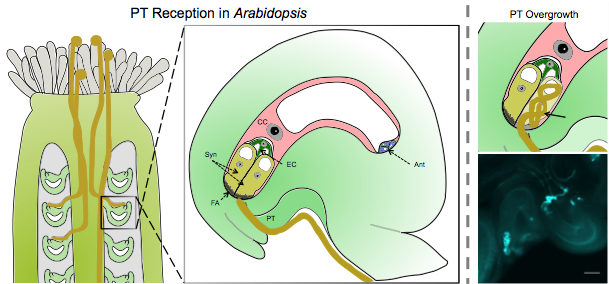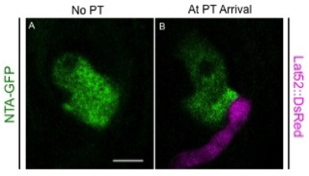Pollen Tube Reception
How do cells sense and establish communication with other cells in order to allow beneficial invasions and prevent harmful invasions?
Plant pollination is an excellent system for gaining insight into this question because intercellular communication between male and female tissues is critical for the recognition of compatible pollen, the guidance of tip-growing pollen tubes (PTs) to the ovules, and finally, the entry of the PT into the female gametophyte and release of the sperm cells so that double fertilization can occur to produce viable seeds. In order to deliver the sperm cells to the female gametes, the PT must sense that it has arrived at the right place and change its growth pattern from tip-growth to explosive growth as it “invades” a synergid cell. Female gametophytic mutations in FERONIA (FER), a receptor-like kinase, and NORTIA (NTA), a member of the MILDEW RESISTANCE LOCUS O (MLO) family of 7-transmembrane proteins, cause PTs to continue growing inside of the receptive synergid instead of rupturing to release the sperm, indicating that these genes form part of the signaling network. This project is aimed at further elucidation of the molecular mechanisms used for communication between the synergid and PT during PT reception, using NTA as the anchor molecule.

Enter Text
Pollen tube reception mutants have problems in male-female communication when the pollen tube arrives at the synergid cells of the female gametophyte. This results in a polen tube overgrowth phenotype where the pollen tube doesn't burst to release the sperms cells. As a result, ovules remain unfertilized and viable seeds are not produced.
NTA-GFP localizes in Golgi-associated compartments and is excluded from the filiform apparatus before pollen tube reception. Jones, et al., 2017
NTA-GFP accumulates at the filiform apparatus when the pollen tube makes contact with the synergid cell. The receptor-like kinase FERONIA is necessary for this redistribution.

